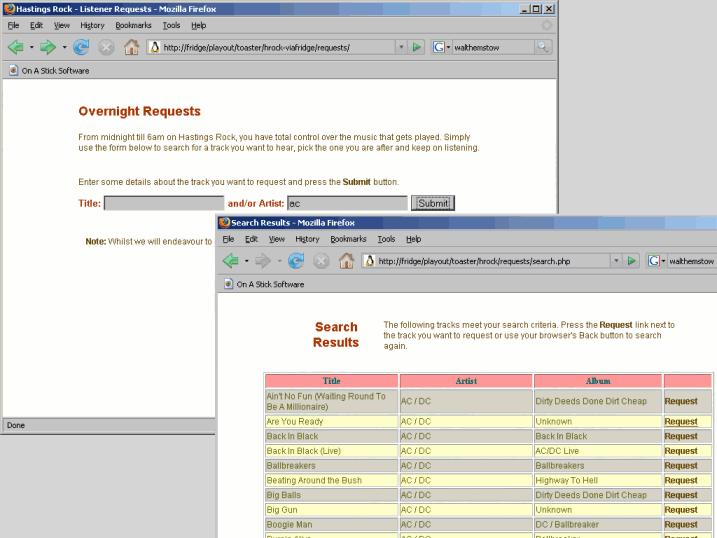
| About |
| Broadcasters |
| Free Trial |
| Purchase |
| News |
| Documentation |
| OAS Audio API |
Automated Listener Requests
This is a concept being pioneered by OAS to introduce a new dimension in listener interaction. The premise is quite straightforward - most small scale radio stations (and many larger ones as well) have periods of automated ie. unattended operation. Mostly this is driven by cost or staffing issues (overnight automation is a common scenario), either way during these periods the system is left to execute a pre-prepared playlist with jingles (and possibly adverts) included at specified intervals.
Automated Listener Requests offers up the ability for listeners to send in their requests and have them automatically included for playback during this period. No presenter or operator involvement is required - the system just accepts the request and schedules it in appropriately. This also includes the capability to prevent repeated tracks occurring too frequently and maintaining the jingle/advert playback at the designated interval.
The web based system
OAS first trialed the concept on Hastings Rock during one of their RSL broadcasts in 2006. The system was run overnight and provided the listeners with a web based system which allowed them to directly search the Playout database then submit their requested track.

The system worked by using server side scripting to enable access to the database and process the requests. This also provided filtering (eg. on user's IP addresses) to prevent abuse of the system.
The concept proved very successful and has been run during every broadcast since then, affectionately referred to as "robojock".
However there are several significant problems with this system not least being fairly complex to set up. You also need a web server with scripting support (most web hosting companies will charge premium rates for this) and there are also security risks in exposing your Playout database to the outside world. If you are interested in deploying such a system though you can find more information on it, along with sample scripts here.
 |
OAS Request Manager OAS Request Manager is a new optional component available freely to all licensed users of the full version of Playout. This package allows not only requests to be retrieved from suitable web pages but also via email and mobile phone (SMS) text messages. This then allows your listeners to simply text the name of their track to you via your normal text number and Request Manager handles the processing and submission of the request to Playout. This approach makes it much simpler (and safer) to deploy on a station. Request Manager can be installed on either the same PC as that which hosts Playout itself or another machine which has (network) access to the Playout database. |
|
|
One key difference though is listeners cannot search your system to find the exact track they wish to request. Therefore Request Manager includes a special pattern matching capability which enables it to determine the closest track by comparing the text message content against the Title and Artist fields held in the database. The software is configurable to take into account possible mis-spellings and filtering of commonly occurring words eg. "the", "a", "and" etc.
If a close enough match is found, the request is passed to Playout for inclusion in the automation sequence. Playout includes logic to ensure that that identical tracks or tracks by the same artist do not occur together to ensure a smooth playback. It also ensures that jingles and/or ad breaks are included at the specified frequency during playback.
For a mainstream station playing track on which average 3 minutes, normally a request will be aired in the about 10 minutes after it is initially received and processed into Playout.
|
|
After successful trials on the community station Unity101 earlier this year, the station has rolled out the request system full time during their overnight periods of automation. Named "Uplay", the system allows requests to be sent in via text or the web. For more information, you can download the Automated Listener Request Concept guide. This explains the concept in greater depth and covers what you need in order to realise the request system. |



